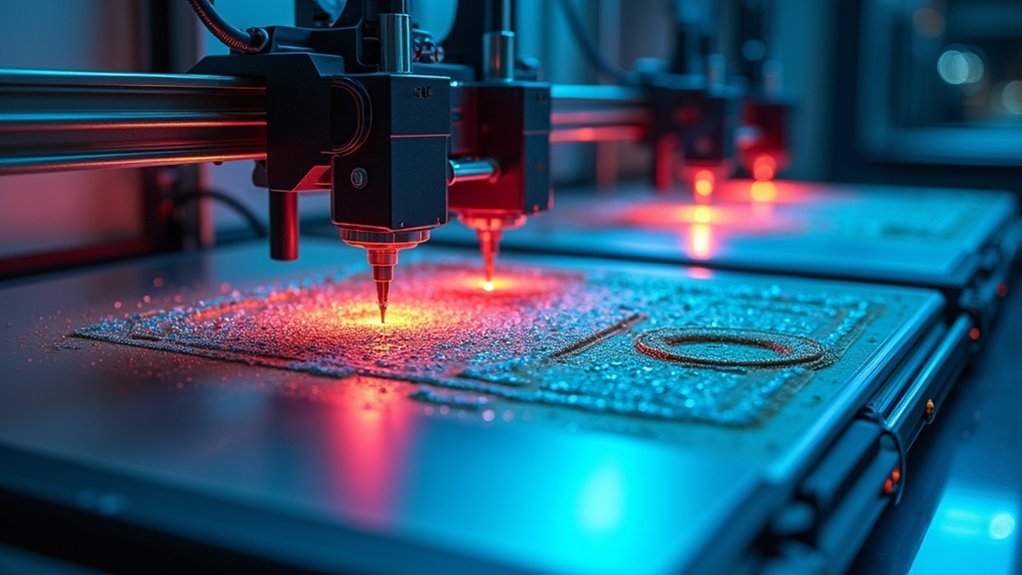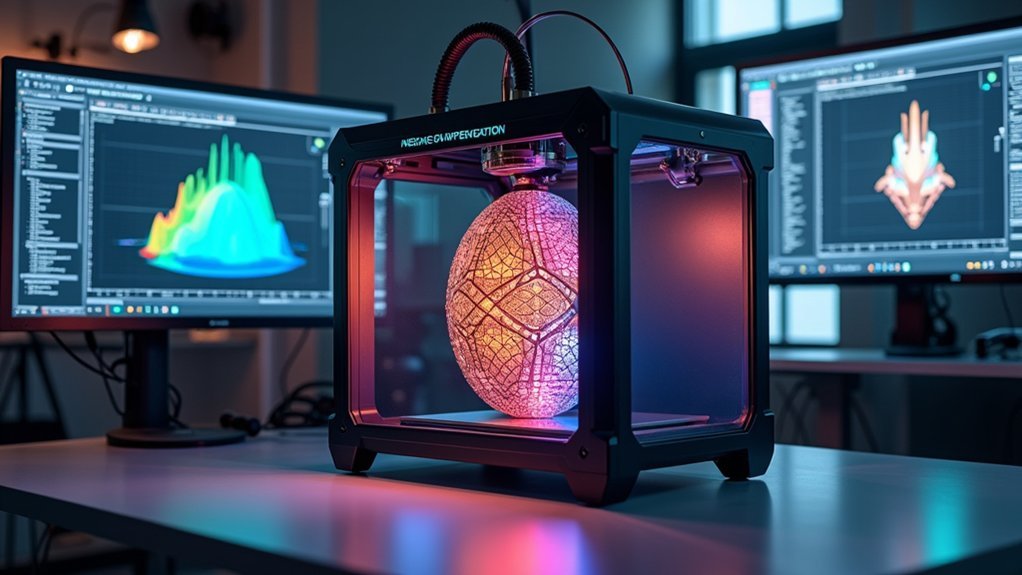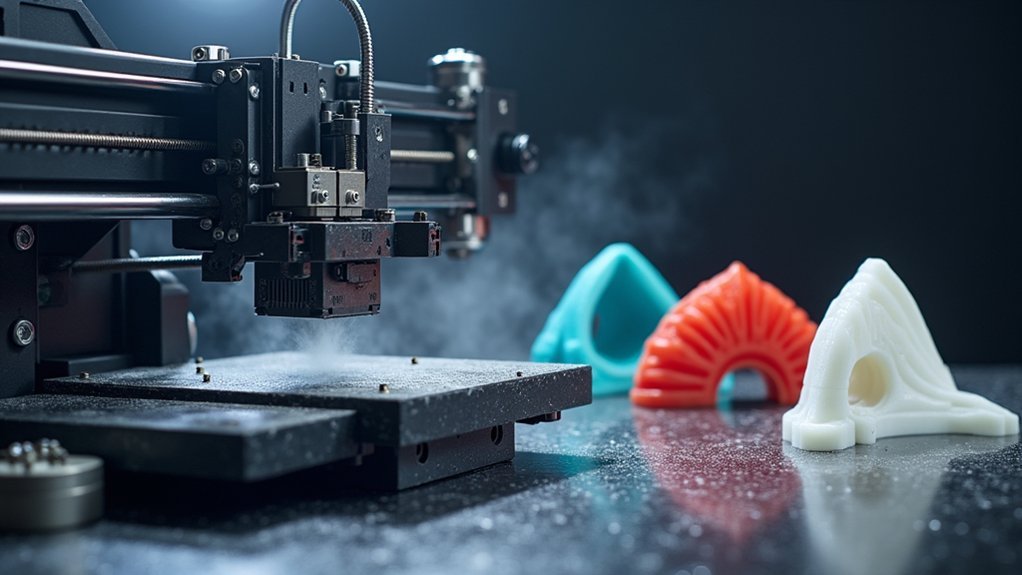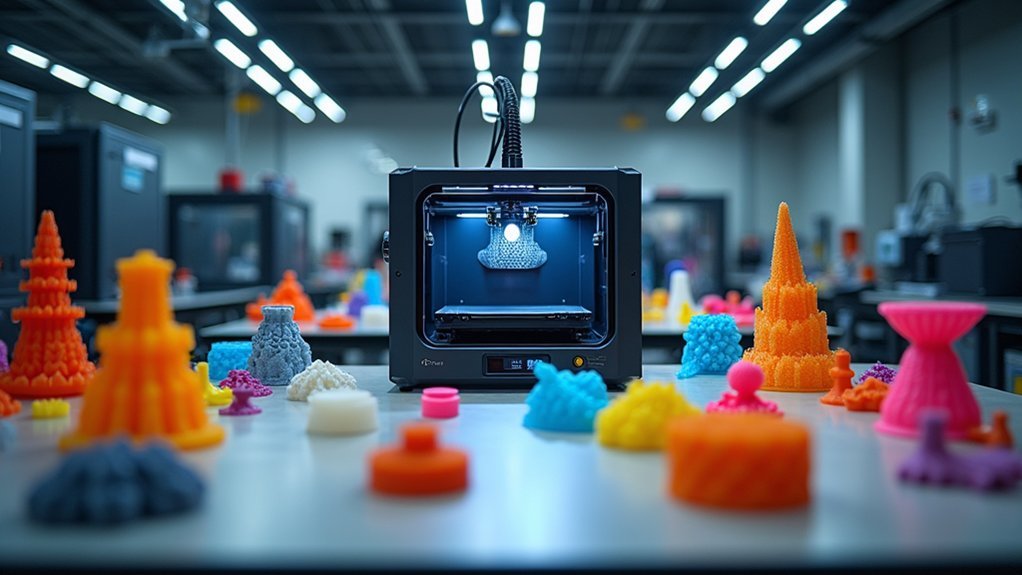Industrial multi-material 3D printing revolutionizes manufacturing by letting you integrate functional inks, conductive polymers, and shape-memory alloys into single components. You’ll create patient-specific medical implants, lightweight aerospace parts reducing weight by 30%, and automotive components with embedded sensors for real-time monitoring. While challenges include weak material joints and complex post-processing, you’re gaining access to sophisticated design tools and topology optimization software. This technology’s transforming industries from healthcare to aerospace with unprecedented capabilities awaiting your exploration.
Advanced Material Integration Technologies

When you’re working with multi-material 3D printing, advanced material integration technologies revolutionize what’s possible by incorporating functional inks and pastes that embed critical properties like conductivity and magnetism directly into your printed objects.
These materials science breakthroughs allow you to create sophisticated components with enhanced mechanical properties through multi-material additive manufacturing processes.
You’ll find that shape-memory alloys and conductive polymers expand your capabilities considerably, allowing you to produce self-healing structures and integrate electrical circuits seamlessly within your designs.
Advanced material integration technologies facilitate bespoke component production across healthcare, automotive, and consumer technology sectors. This approach reduces your manufacturing costs while enabling rapid prototyping.
Continuous advancements in functional inks guarantee you’re always accessing improved performance and expanded application ranges for your printed products.
Functional Ink Development and Applications
As functional ink development continues to accelerate, you’re witnessing a transformation in how 3D printing integrates multiple materials with specialized properties into single components.
You can now utilize conductive polymers and nanocomposites to create electrical circuits directly within complex structures, eliminating traditional assembly processes. These functional inks enhance mechanical properties while maintaining structural integrity throughout your printed objects.
Shape-memory alloys in your ink formulations respond to temperature changes, enabling self-healing and adaptive capabilities.
Shape-memory alloys transform 3D printed components into intelligent materials that automatically adapt and repair themselves when heated.
You’ll find biocompatible materials specifically designed for medical applications, allowing you to produce patient-specific implants and tissue engineering solutions.
The increased accessibility of multi-material printing equipment lets you experiment with innovative material combinations, pushing the boundaries of what’s possible in functional device manufacturing and expanding your design possibilities considerably.
Design Software and Optimization Tools

The evolution of design software has revolutionized your approach to multi-material 3D printing, with platforms like SolidWorks and Fusion 360 now offering sophisticated tools for visualizing and creating complex geometries that integrate multiple materials seamlessly. You’ll discover topology optimization tools like OptiStruct and Tosca enhance material distribution based on performance criteria, maximizing component efficiency.
| Software Type | Key Tools | Primary Function |
|---|---|---|
| Design Software | SolidWorks, Fusion 360 | Complex geometry creation |
| Topology Optimization | OptiStruct, Tosca | Material distribution optimization |
| Multi-Material Specialists | Materialise Magics, 3D Systems Geomagic | Multi-material structure design |
| Advanced Techniques | Multi-material topology optimization | Functionally graded materials |
| Workflow Integration | Combined platforms | Concept-to-production streamlining |
These optimization tools enable functionally graded materials and streamline your workflow from concept to production, considerably improving multi-material 3D printing capabilities.
Healthcare and Biomedical Manufacturing Solutions
While traditional manufacturing methods often force compromises between functionality and biocompatibility, multi-material 3D printing has transformed healthcare manufacturing by enabling you to create patient-specific solutions that seamlessly integrate multiple biocompatible materials within single devices.
You’ll discover revolutionary healthcare solutions through:
- Patient-specific implants – Create tailored models that improve surgical outcomes and enhance patient comfort.
- Wearable monitoring devices – Integrate sensors directly into flexible materials for real-time health data collection.
- Customized prosthetics – Reduce lead times and costs while delivering perfectly fitted orthotic devices.
- Tissue engineering scaffolds – Fabricate biocompatible structures that support cell growth and regeneration.
Additionally, you can incorporate conductive polymers to develop smart medical devices that monitor biological signals and respond dynamically to changing patient needs.
Automotive and Aerospace Component Production

You’ll find that multi-material 3D printing transforms automotive and aerospace manufacturing by producing components that are markedly lighter than traditional alternatives while maintaining structural integrity.
This technology lets you integrate various functional materials in a single print process, creating optimized parts that enhance fuel efficiency in vehicles and reduce weight in aircraft and satellites.
You can now embed advanced materials like conductive polymers and shape-memory alloys directly into components, enabling enhanced safety features such as integrated sensor systems and self-healing structures.
Lightweight Component Optimization
When automotive and aerospace manufacturers need to balance strength with weight reduction, multi-material 3D printing delivers game-changing solutions.
You can now integrate carbon fiber composites with lightweight metals to create components that maintain structural integrity while dramatically reducing mass. This approach enables significant fuel efficiency improvements and enhanced performance across vehicles and aircraft.
Your mechanical engineering teams can leverage these enhancement strategies:
- Topology optimization – Design components using minimal material without compromising strength
- Advanced material integration – Combine carbon fiber composites with lightweight metals for peak performance
- Complex geometries creation – Produce conformal structures impossible with traditional manufacturing
- Rapid prototyping cycles – Accelerate development timelines for lightweight components through faster iteration
You’ll achieve cost savings while creating aerodynamically superior parts that traditional methods can’t match.
Enhanced Safety Features
As safety regulations tighten across automotive and aerospace industries, multi-material 3D printing transforms how manufacturers approach critical component design.
You can now create crash-absorbent structures with complex geometries that traditional manufacturing can’t achieve, greatly improving occupant protection during collisions. Enhanced safety features emerge through embedded functional materials that enable real-time monitoring systems and predictive maintenance capabilities.
In aerospace applications, you’ll produce components that withstand extreme conditions while maintaining structural integrity.
The technology allows you to embed multiple materials with varying properties, creating parts that actively respond to environmental changes. This responsive capability enhances safety features across both automotive and aerospace designs, while lightweight components contribute to better fuel efficiency and improved collision performance through reduced vehicle weight.
Current Challenges and Technical Limitations
Despite remarkable advances in 3D printing technology, several technical barriers continue to hinder the widespread adoption of multi-material printing systems.
You’ll encounter significant hurdles when attempting to implement these sophisticated manufacturing solutions in your operations.
The primary technical limitations you’ll face include:
- Material compatibility issues – Different materials often won’t bond effectively, creating weak joints and compromised structural integrity in your finished products.
- Limited printer accessibility and reliability – Most current systems can’t handle diverse material types consistently, restricting your manufacturing flexibility.
- Insufficient new materials development – Available options frequently don’t meet complex application requirements, limiting your project possibilities.
- Complex post-processing demands – Multi-material 3D printing requires extensive finishing steps, complicating your production workflows and increasing operational costs.
Emerging Market Applications and Opportunities
You’ll find that multi-material 3D printing is revolutionizing healthcare by enabling patient-specific implants, wearable sensors, and personalized medical devices that weren’t possible with traditional manufacturing.
The aerospace industry’s embracing this technology to create optimized satellite and aircraft components that reduce weight while enhancing performance.
These emerging applications represent just the beginning of how multi-material capabilities are opening new markets and transforming established industries.
Healthcare Innovation Potential
Healthcare’s transformation through 3D printing isn’t just promising—it’s already revolutionizing how medical professionals approach patient care.
Multi-material 3D printing enables you to create patient-specific models and custom implants that dramatically improve surgical outcomes while delivering truly personalized healthcare solutions.
This technology’s impact extends across multiple healthcare applications:
- Wearable Health Monitoring – Functional materials create sensors that track essential signs and health metrics in real-time.
- Rapid Medical Device Prototyping – Considerably reduces development time and costs for new healthcare technologies.
- Advanced Tissue Engineering – Biocompatible materials and soft robotics advance regenerative medicine applications.
- Custom Prosthetics and Orthotics – Enhanced fit and comfort through personalized manufacturing solutions.
You’ll find healthcare markets increasingly adopting these innovations for improved patient outcomes.
Aerospace Manufacturing Growth
Aerospace manufacturing stands at the forefront of multi-material 3D printing adoption, where the technology’s ability to produce lightweight components is transforming aircraft design and performance.
You’ll find that this revolutionary approach can reduce aircraft weight by up to 30%, directly enhancing fuel efficiency. The creation of complex geometries that traditional methods can’t achieve enables innovative turbine blades and structural parts that weren’t previously possible.
You’re witnessing development cycles compressed from months to weeks through rapid prototyping capabilities.
Advanced material science now incorporates shape-memory alloys and conductive polymers, creating smart components that respond to environmental changes in real-time.
As demand for specialized parts grows, the aerospace manufacturing market for multi-material 3D printing is projected to reach $2.4 billion by 2026.
Future Technology Trends and Industry Impact
As industrial multi-material 3D printing continues evolving, you’ll witness transformative technology trends reshaping manufacturing landscapes across sectors.
The integration of AI and robotics will enhance your design capabilities while automating complex processes. You’ll see continuous development of new materials like conductive polymers and shape-memory alloys expanding functional applications across various industries.
Key future directions you can expect include:
- Production scaling – Shifting from prototyping to mass production in aerospace and healthcare sectors
- Standardization initiatives – Establishing consistent quality and compatibility across different applications
- Advanced material innovation – Developing specialized polymers and alloys for industry-specific requirements
- Workforce development – Training professionals in multi-material design and manufacturing techniques
These advancements will fundamentally transform how you approach industrial manufacturing processes.
Frequently Asked Questions
What Are the Benefits of Multi Material 3D Printing?
You’ll gain enhanced functionality by embedding conductive materials, streamline designs with integrated components, accelerate innovation through custom devices, reduce costs with intricate geometries, and enjoy unprecedented design flexibility for complex structures.
What Are 5 Industries That 3D Design Is Used in Today?
You’ll find 3D design extensively used in healthcare for patient-specific implants, automotive for lightweight components, aerospace for optimized parts, consumer electronics for intricate devices, and construction for architectural models.
Why Do You Think 3D Printing Is Becoming More Popular in Various Industries?
You’re seeing 3D printing gain popularity because it’s cutting manufacturing costs, speeding up production, and enabling custom designs. You can create complex parts on-demand without expensive tooling or long lead times.
Which Industry Has Been Greatly Impacted by 3D Printing Technology?
You’ll find healthcare’s been most dramatically transformed by 3D printing technology. You can now create patient-specific models, custom implants, and personalized medical devices that weren’t possible before, revolutionizing surgical planning and treatment approaches.





Leave a Reply